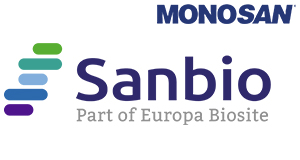Anti-SLC4A1/CD233/Band 3 Antibody Picoband™ (monoclonal, 5G2G7)
Anti-SLC4A1/CD233/Band 3 Antibody Picoband™ (monoclonal, 5G2G7)
SKU
SANMON23879
Packaging Unit
100μg
Manufacturer
Sanbio / Monosan
Availability:
loading...
Price is loading...
Clone Number: 5G2G7
Immunogen: E.coli-derived human SLC4A1 (Position: E28-N365). Human SLC4A1 shares 75.7% and 74.5% amino acid (aa) sequence identity with and rat SLC4A1, respectively.
Concentration: Adding 0.2 ml of distilled water =f 500 μg/ml.
Format: Lyophilized
Storage buffer: Each vial contains 4mg Trehalose, 0.9mg NaCl, 0.2mg Na2HPO4, 0.05mg NaN3.
Additional info: At -20°C for one year from date of receipt. After reconstitution, at 4°C for one month. It can also be aliquotted and stored frozen at -20°C for six months. Avoid repeated freezing and thawing.Adding 0.2 ml of distilled water will yield a concentration of 500 μg/ml. Background: Band 3 is also known as SLC4A1. The protein encoded by this gene is part of the anion exchanger (AE) family and is expressed in the erythrocyte plasma membrane, where it functions as a chloride/bicarbonate exchanger involved in carbon dioxide transport from tissues to lungs. The protein comprises two domains that are structurally and functionally distinct. The N-terminal 40kDa domain is located in the cytoplasm and acts as an attachment site for the red cell skeleton by binding ankyrin. The glycosylated C-terminal membrane-associated domain contains 12-14 membrane spanning segments and carries out the stilbene disulphonate-sensitive exchange transport of anions. The cytoplasmic tail at the extreme C-terminus of the membrane domain binds carbonic anhydrase II. The encoded protein associates with the red cell membrane protein glycophorin A and this association promotes the correct folding and translocation of the exchanger. This protein is predominantly dimeric but forms tetramers in the presence of ankyrin. Many mutations in this gene are known in man, and these mutations can lead to two types of disease: destabilization of red cell membrane leading to hereditary spherocytosis, and defective kidney acid secretion leading to distal renal tubular acidosis. Other mutations that do not give rise to disease result in novel blood group antigens, which form the Diego blood group system. Subcellular Localization: Tissue Specificity:
Applications: WB,IHC,FC
Immunogen: E.coli-derived human SLC4A1 (Position: E28-N365). Human SLC4A1 shares 75.7% and 74.5% amino acid (aa) sequence identity with and rat SLC4A1, respectively.
Concentration: Adding 0.2 ml of distilled water =f 500 μg/ml.
Format: Lyophilized
Storage buffer: Each vial contains 4mg Trehalose, 0.9mg NaCl, 0.2mg Na2HPO4, 0.05mg NaN3.
Additional info: At -20°C for one year from date of receipt. After reconstitution, at 4°C for one month. It can also be aliquotted and stored frozen at -20°C for six months. Avoid repeated freezing and thawing.Adding 0.2 ml of distilled water will yield a concentration of 500 μg/ml. Background: Band 3 is also known as SLC4A1. The protein encoded by this gene is part of the anion exchanger (AE) family and is expressed in the erythrocyte plasma membrane, where it functions as a chloride/bicarbonate exchanger involved in carbon dioxide transport from tissues to lungs. The protein comprises two domains that are structurally and functionally distinct. The N-terminal 40kDa domain is located in the cytoplasm and acts as an attachment site for the red cell skeleton by binding ankyrin. The glycosylated C-terminal membrane-associated domain contains 12-14 membrane spanning segments and carries out the stilbene disulphonate-sensitive exchange transport of anions. The cytoplasmic tail at the extreme C-terminus of the membrane domain binds carbonic anhydrase II. The encoded protein associates with the red cell membrane protein glycophorin A and this association promotes the correct folding and translocation of the exchanger. This protein is predominantly dimeric but forms tetramers in the presence of ankyrin. Many mutations in this gene are known in man, and these mutations can lead to two types of disease: destabilization of red cell membrane leading to hereditary spherocytosis, and defective kidney acid secretion leading to distal renal tubular acidosis. Other mutations that do not give rise to disease result in novel blood group antigens, which form the Diego blood group system. Subcellular Localization: Tissue Specificity:
Applications: WB,IHC,FC
| SKU | SANMON23879 |
|---|---|
| Manufacturer | Sanbio / Monosan |
| Manufacturer SKU | MON23879 |
| Package Unit | 100μg |
| Quantity Unit | STK |
| Reactivity | Human |
| Clonality | Monoclonal |
| Application | Western Blotting, Flow Cytometry, Immunohistochemistry |
| Isotype | IgG2b |
| Host | Mouse |
| Conjugate | Unconjugated |
| Product information (PDF) |
|
| MSDS (PDF) |
|

 Deutsch
Deutsch







